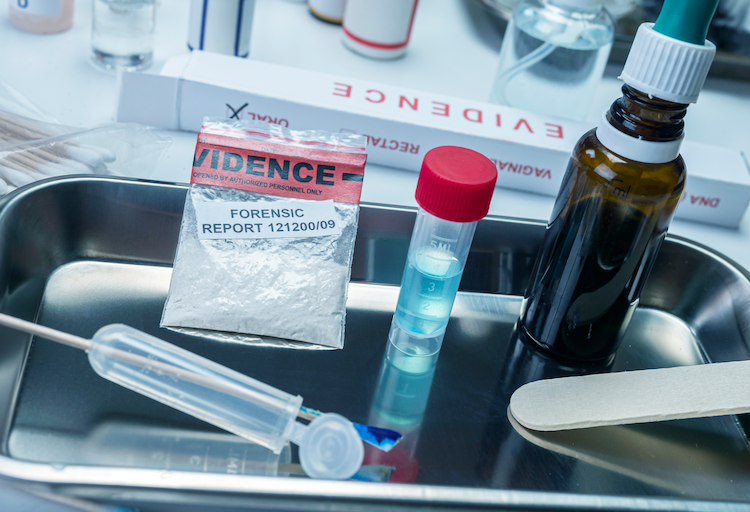Supreme Court Clarifies Application of Confrontation Clause to Forensic Analysis

In Smith v. Arizona, 602 U.S. ____ (2024), the U.S. Supreme Court held that when an expert conveys an absent lab analyst’s statements in support of the expert’s opinion, and the statements provide that support only if true, then the statements come into evidence for their truth, and implicate the Sixth Amendment’s Confrontation Clause. The Court’s decision was unanimous.
Facts of the Case
Arizona law enforcement officers found petitioner Jason Smith with a large quantity of what appeared to be drugs and drug-related items. Smith was charged with various drug offenses, and the State sent the seized items to a crime lab for scientific analysis. Analyst Elizabeth Rast ran forensic tests on the items and concluded that they contained usable quantities of methamphetamine, marijuana, and cannabis.
Rast prepared a set of typed notes and a signed report about the testing. The State originally planned for Rast to testify about those matters at Smith’s trial, but Rast stopped working at the lab prior to trial. As a result, the State substituted another analyst, Greggory Longoni, to “provide an independent opinion on the drug testing per- formed by Elizabeth Rast.”
At trial, Longoni conveyed to the jury what Rast’s records revealed about her testing, before offering his “independent opinion” of each item’s identity. Smith was convicted. On appeal, he argued that the State’s use of a substitute expert to convey the substance of Rast’s materials violated his Confrontation Clause rights.
The Arizona Court of Appeals rejected Smith’s challenge, holding that Longoni could constitutionally present his own expert opinions based on his review of Rast’s work because her statements were then used only to show the basis of his opinion and not to prove their truth.
Supreme Court’s Decision
Th Supreme Court vacated and remanded by a vote of 9-0. Justice Elena Kagan wrote on behalf of the unanimous Court.
The Court’s decision relied heavily on its prior ruling in Crawford v. Washington, 541 U.S. 36 (2004). In that case, the justices held that the Confrontation Clause “bars the admission at trial of an absent witness’s statements—however trustworthy a judge might think them—unless the witness is unavailable and the defendant had a prior chance” for cross examination.
As Justice Kagan explained, the Confrontation Clause “protects a defendant’s right of cross-examination by limiting the prosecution’s ability to introduce statements made by people not in the courtroom.” Accordingly, the Clause bars the admission at trial of an absent witness’s statements unless the witness is unavailable and the defendant had a prior chance to subject her to cross-examination.
Justice Kagan went on to explain that prohibition applies in full to forensic evidence, meaning that a prosecutor can’t introduce an absent laboratory analyst’s testimonial out-of- court statements to prove the results of forensic testing. “Those statements, as we have explained, come into evidence for their truth—because only if true can they provide a reason to credit the substitute expert,” Justice Kagan explained. “So a defendant has the right to cross-examine the person who made them.”
The question before the Court involved the application of those principles to a case in which an expert witness restates an absent lab analyst’s factual assertions to support his own opinion testimony. The justices ultimately rejected that the lower court’s conclusion the requirement that the prosecution uses out-of-court statements for “the truth of the matter asserted” is not met when an expert recites another analyst’s statements as the basis for his opinion.
“When an expert conveys an absent analyst’s statements in support of his opinion, and the statements provide that support only if true, then the statements come into evidence for their truth. As this dispute illustrates, that will generally be the case when an expert relays an absent lab analyst’s statements as part of offering his opinion,” Justice Kagan wrote. “And if those statements are testimonial too— an issue we briefly address but do not resolve as to this case—the Confrontation Clause will bar their admission.”
Notably, the Court did not address whether the out-of-court statements Longoni conveyed were testimonial. The issue must now be addressed by the lower court.
Previous Articles
Key Takeaways from Oral Arguments in Court’s Controversial Voting-Rights Case
by DONALD SCARINCI on November 12, 2025
The U.S. Supreme Court recently heard oral arguments in Louisiana v. Callais, which involves a key ...
Key Cases to Watch During the Supreme Court’s November Sitting
by DONALD SCARINCI on November 5, 2025
The U.S. Supreme Court’s November sitting begins on November 3 and concludes on November 12, 2025...
SCOTUS Clears Way to Terminate Protected Status for Venezuelan Nationals
by DONALD SCARINCI on October 29, 2025
On October 3, 2025, the U.S. Supreme Court granted an emergency request from the Trump Administrati...
The Amendments
-
Amendment1
- Establishment ClauseFree Exercise Clause
- Freedom of Speech
- Freedoms of Press
- Freedom of Assembly, and Petitition
-
Amendment2
- The Right to Bear Arms
-
Amendment4
- Unreasonable Searches and Seizures
-
Amendment5
- Due Process
- Eminent Domain
- Rights of Criminal Defendants
Preamble to the Bill of Rights
Congress of the United States begun and held at the City of New-York, on Wednesday the fourth of March, one thousand seven hundred and eighty nine.
THE Conventions of a number of the States, having at the time of their adopting the Constitution, expressed a desire, in order to prevent misconstruction or abuse of its powers, that further declaratory and restrictive clauses should be added: And as extending the ground of public confidence in the Government, will best ensure the beneficent ends of its institution.





